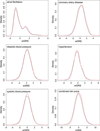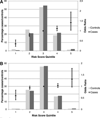Multilocus genetic risk score associates with ischemic stroke in case-control and prospective cohort studies
- PMID: 24436234
- PMCID: PMC4006951
- DOI: 10.1161/STROKEAHA.113.002938
Multilocus genetic risk score associates with ischemic stroke in case-control and prospective cohort studies
Abstract
Background and purpose: Genome-wide association studies have revealed multiple common variants associated with known risk factors for ischemic stroke (IS). However, their aggregate effect on risk is uncertain. We aimed to generate a multilocus genetic risk score (GRS) for IS based on genome-wide association studies data from clinical-based samples and to establish its external validity in prospective population-based cohorts.
Methods: Three thousand five hundred forty-eight clinic-based IS cases and 6399 controls from the Wellcome Trust Case Control Consortium 2 were used for derivation of the GRS. Subjects from the METASTROKE consortium served as a replication sample. The validation sample consisted of 22 751 participants from the Cohorts for Heart and Aging Research in Genomic Epidemiology consortium. We selected variants that had reached genome-wide significance in previous association studies on established risk factors for IS.
Results: A combined GRS for atrial fibrillation, coronary artery disease, hypertension, and systolic blood pressure significantly associated with IS both in the case-control samples and in the prospective population-based studies. Subjects in the top quintile of the combined GRS had >2-fold increased risk of IS compared with subjects in the lowest quintile. Addition of the combined GRS to a simple model based on sex significantly improved the prediction of IS in the combined clinic-based samples but not in the population-based studies, and there was no significant improvement in net reclassification.
Conclusions: A multilocus GRS based on common variants for established cardiovascular risk factors was significantly associated with IS both in clinic-based samples and in the general population. However, the improvement in clinical risk prediction was found to be small.
Keywords: genetics; polymorphism, genetic; risk assessment; risk factors.
Figures



References
-
- Bonita R. Epidemiology of stroke. Lancet. 1992;339:342–344. - PubMed
-
- Lopez AD, Mathers CD, Ezzati M, Jamison DT, Murray CJ. Global and regional burden of disease and risk factors, 2001: systematic analysis of population health data. Lancet. 2006;367:1747–1757. - PubMed
-
- Dichgans M. Genetics of ischaemic stroke. Lancet Neurol. 2007;6:149–161. - PubMed
-
- Bevan S, Traylor M, Adib-Samii P, Malik R, Paul NL, Jackson C, et al. Genetic heritability of ischemic stroke and the contribution of previously reported candidate gene and genomewide associations. Stroke. 2012;43:3161–3167. - PubMed
-
- Dichgans M, Malik R, König IR, Rosand J, Clarke R, Gretarsdottir S, et al. Shared genetic susceptibility to ischemic stroke and coronary artery disease: a genome-wide analysis of common variants. [Accessed December 21, 2013];Stroke. 2013 Nov 21; http://stroke.ahajournals.org/content/early/2013/11/21/STROKEAHA.113.002.... - PMC - PubMed
Publication types
MeSH terms
Grants and funding
- Z01 AG007380/ImNIH/Intramural NIH HHS/United States
- HL080295/HL/NHLBI NIH HHS/United States
- HHSN268201100012C/HL/NHLBI NIH HHS/United States
- UL1RR025005/RR/NCRR NIH HHS/United States
- N02-HL-6-4278/HL/NHLBI NIH HHS/United States
- N01-HC-25195/HC/NHLBI NIH HHS/United States
- N01 HC055022/HC/NHLBI NIH HHS/United States
- UL1 RR033176/RR/NCRR NIH HHS/United States
- N01 HC085086/HC/NHLBI NIH HHS/United States
- U01 HG 004446/HG/NHGRI NIH HHS/United States
- N01 HC055016/HL/NHLBI NIH HHS/United States
- HHSN268201100009I/HL/NHLBI NIH HHS/United States
- N01 HC085080/HL/NHLBI NIH HHS/United States
- UL1RR033176/RR/NCRR NIH HHS/United States
- UL1TR000124/TR/NCATS NIH HHS/United States
- R01 NS45012/NS/NINDS NIH HHS/United States
- R01 NS045012/NS/NINDS NIH HHS/United States
- R01 NS017950/NS/NINDS NIH HHS/United States
- R01 NS042733/NS/NINDS NIH HHS/United States
- U01 HG004446/HG/NHGRI NIH HHS/United States
- Z01 AG000954/ImNIH/Intramural NIH HHS/United States
- N01 HC055019/HL/NHLBI NIH HHS/United States
- 095626/WT_/Wellcome Trust/United Kingdom
- N01 HC085081/HC/NHLBI NIH HHS/United States
- R01HL59367/HL/NHLBI NIH HHS/United States
- HHSN268201100010C/HL/NHLBI NIH HHS/United States
- UL1 RR025005/RR/NCRR NIH HHS/United States
- R01 AG015928/AG/NIA NIH HHS/United States
- HHSN268201100008C/HL/NHLBI NIH HHS/United States
- U01 HL080295/HL/NHLBI NIH HHS/United States
- N01 HC075150/HC/NHLBI NIH HHS/United States
- U01 HL096917/HL/NHLBI NIH HHS/United States
- HHSN268201100008I/HL/NHLBI NIH HHS/United States
- R01 HL087676/HL/NHLBI NIH HHS/United States
- N02 HL064278/HL/NHLBI NIH HHS/United States
- HHSN268201100005G/HL/NHLBI NIH HHS/United States
- N01 HC085082/HL/NHLBI NIH HHS/United States
- N01-HC-55022/HC/NHLBI NIH HHS/United States
- N01-HC-85081/HC/NHLBI NIH HHS/United States
- R01 HL059367/HL/NHLBI NIH HHS/United States
- N01 HC055021/HL/NHLBI NIH HHS/United States
- HHSN268201100007C/HL/NHLBI NIH HHS/United States
- HL105756/HL/NHLBI NIH HHS/United States
- N01 HC015103/HC/NHLBI NIH HHS/United States
- N01 HC085086/HL/NHLBI NIH HHS/United States
- N01-HC-55016/HC/NHLBI NIH HHS/United States
- N01 HC085083/HC/NHLBI NIH HHS/United States
- Z01 AG-000015-50/AG/NIA NIH HHS/United States
- N01 HC085083/HL/NHLBI NIH HHS/United States
- N01 HC055018/HC/NHLBI NIH HHS/United States
- R56 AG020098/AG/NIA NIH HHS/United States
- N01 HC025195/HC/NHLBI NIH HHS/United States
- HHSN268201100011I/HL/NHLBI NIH HHS/United States
- HHSN268201100011C/HL/NHLBI NIH HHS/United States
- R01 HL086694/HL/NHLBI NIH HHS/United States
- N01 HC085085/HC/NHLBI NIH HHS/United States
- N01 HC055015/HL/NHLBI NIH HHS/United States
- R01 HL087652/HL/NHLBI NIH HHS/United States
- AG033193/AG/NIA NIH HHS/United States
- 085475/B/08/Z/WT_/Wellcome Trust/United Kingdom
- AG-20098/AG/NIA NIH HHS/United States
- HL087652/HL/NHLBI NIH HHS/United States
- UL1 TR000124/TR/NCATS NIH HHS/United States
- N01-HC-55021/HC/NHLBI NIH HHS/United States
- HHSN268200625226C/PHS HHS/United States
- U01 HG004402/HG/NHGRI NIH HHS/United States
- N01-HC-85086/HC/NHLBI NIH HHS/United States
- R01-HL087641/HL/NHLBI NIH HHS/United States
- R01 HL093029/HL/NHLBI NIH HHS/United States
- NS17950/NS/NINDS NIH HHS/United States
- R01 HL105756/HL/NHLBI NIH HHS/United States
- U01HG004402/HG/NHGRI NIH HHS/United States
- AG08122/AG/NIA NIH HHS/United States
- AG-027058/AG/NIA NIH HHS/United States
- N01 HC055020/HL/NHLBI NIH HHS/United States
- N01 HC085082/HC/NHLBI NIH HHS/United States
- N01-HC-85082/HC/NHLBI NIH HHS/United States
- R01 NS-42733/NS/NINDS NIH HHS/United States
- N01 HC055019/HC/NHLBI NIH HHS/United States
- P30 DK063491/DK/NIDDK NIH HHS/United States
- N01 HC085080/HC/NHLBI NIH HHS/United States
- HHSN268200782096C/HG/NHGRI NIH HHS/United States
- HHSN268201100006C/HL/NHLBI NIH HHS/United States
- R01 AG008122/AG/NIA NIH HHS/United States
- N01 HC-55222/HC/NHLBI NIH HHS/United States
- N01-HC-55019/HC/NHLBI NIH HHS/United States
- HHSN268201200036C/HL/NHLBI NIH HHS/United States
- P30 DK072488/DK/NIDDK NIH HHS/United States
- N01 HC025195/HL/NHLBI NIH HHS/United States
- R01 AG033193/AG/NIA NIH HHS/United States
- R01HL087641/HL/NHLBI NIH HHS/United States
- U01 NS069208/NS/NINDS NIH HHS/United States
- R01 NS039987/NS/NINDS NIH HHS/United States
- N01-HC-55015/HC/NHLBI NIH HHS/United States
- N01 HC055222/HL/NHLBI NIH HHS/United States
- HHSN268201100005I/HL/NHLBI NIH HHS/United States
- N01 HC085079/HL/NHLBI NIH HHS/United States
- N01-HC-85083/HC/NHLBI NIH HHS/United States
- N01-HC-75150/HC/NHLBI NIH HHS/United States
- N01-HC-55020/HC/NHLBI NIH HHS/United States
- N01-HC-85080/HC/NHLBI NIH HHS/United States
- Z01 AG-000954-06/AG/NIA NIH HHS/United States
- R01 HL080295/HL/NHLBI NIH HHS/United States
- N01 HC055015/HC/NHLBI NIH HHS/United States
- U01 HG005157/HG/NHGRI NIH HHS/United States
- N01 HC055021/HC/NHLBI NIH HHS/United States
- HHSN268200782096C/HL/NHLBI NIH HHS/United States
- N01 HC055018/HL/NHLBI NIH HHS/United States
- N01 HC085084/HC/NHLBI NIH HHS/United States
- R01 AG020098/AG/NIA NIH HHS/United States
- U01 HG004436/HG/NHGRI NIH HHS/United States
- HHSN268201100009C/HL/NHLBI NIH HHS/United States
- OSRP2/1006/DMT_/The Dunhill Medical Trust/United Kingdom
- HHSN268201100005C/HL/NHLBI NIH HHS/United States
- DK063491/DK/NIDDK NIH HHS/United States
- HHSN268201100007I/HL/NHLBI NIH HHS/United States
- N01-HC-85079/HC/NHLBI NIH HHS/United States
- N01 HC055022/HL/NHLBI NIH HHS/United States
- U01 NS069208-01/NS/NINDS NIH HHS/United States
- N01 HC055020/HC/NHLBI NIH HHS/United States
- P30 AG010129/AG/NIA NIH HHS/United States
- N01-HC-85239/HC/NHLBI NIH HHS/United States
- AG-023629/AG/NIA NIH HHS/United States
- N01 HC085079/HC/NHLBI NIH HHS/United States
- HL-093029/HL/NHLBI NIH HHS/United States
- N01 HC075150/HL/NHLBI NIH HHS/United States
- N01-HC-55018/HC/NHLBI NIH HHS/United States
- R01 AG023629/AG/NIA NIH HHS/United States
- R01 HL087641/HL/NHLBI NIH HHS/United States
- R01 AG027058/AG/NIA NIH HHS/United States
- N01 HC045133/HC/NHLBI NIH HHS/United States
- 085475/Z/08/Z/WT_/Wellcome Trust/United Kingdom
- N01 HC035129/HC/NHLBI NIH HHS/United States
- R56 AG023629/AG/NIA NIH HHS/United States
- N01 HC085081/HL/NHLBI NIH HHS/United States
- U54 RR020278/RR/NCRR NIH HHS/United States
- N01 HC055016/HC/NHLBI NIH HHS/United States
- Z01 AG000015/ImNIH/Intramural NIH HHS/United States
- R01 NS-39987/NS/NINDS NIH HHS/United States
- R01HL086694/HL/NHLBI NIH HHS/United States
- U01 AG049505/AG/NIA NIH HHS/United States
LinkOut - more resources
Full Text Sources
Other Literature Sources
Medical

